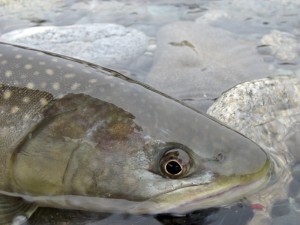 FOR IMMEDIATE RELEASE
FOR IMMEDIATE RELEASE
September 5, 2013
Contact:
Nick Cady, Legal Director 541-434-1463 nick@cascwild.org
Cascadia Wildlands to US Forest Service—18 Years is Too Long to Wait for Action on Bull Trout
Eugene, OR — Cascadia Wildlands filed a 60-day notice of intent to sue the U.S. Forest Service and Bureau of Land Management over their failure to consult and consider the impacts of projects and actions on the critical habitat of federally threatened Bull Trout (Salvelinus confluentus) throughout its range in the Pacific Northwest.
“As a fish that requires cold, clean water and complex aquatic structures, the presence or absence of Bull Trout in our streams and waterways is a true indication of whether or not we are fulfilling our obligation to protect, maintain and enhance our aquatic heritage,” said Nick Cady Cascadia’s Legal Director. “ The current management plans for Bull Trout were put into place in the 1990’s and were only supposed to serve as interim guidance for 18 months. We have been waiting 18 years for the Federal government to release management plans for this important and sensitive fish.”
According to the Endangered Species Act, agencies like the Fish and Wildlife Service and the Forest Service are required to consider the impacts of projects and actions such as their forest plans on listed species and their critical habitats. In September of 2010, the US Fish and Wildlife Service after a long legal battle finally designated critical habitat for the species across the Pacific Northwest. However, the Forest Service has failed to update its 18-year-old conservation plan for the species and ensure that agency actions do not destroy or adversely modify these areas critical to the species persistence.
Bull Trout are native to North America. In the US they are found in Washington, Oregon, Idaho, western Montana and a single river in northern Nevada. They have been likely extirpated in their historic range in northern California.
Bull trout have strict habitat requirements and need cold water (below 55 °F or 13 °C), clean gravel beds, plentiful cover such as downed timber and undercut banks, and large systems of intact waterways for their spawning migrations. As a result, they prefer cold lakes, deep pools in rivers and high mountain streams. Bull trout occasionally visit ocean habitats and have been known to use coastal waters to migrate from one river to another.
“Bull Trout are the “canaries in the coal mine” for aquatic ecosystems in the Pacific Northwest,” said Bob Ferris Executive Director of Cascadia Wildlands. “If we fail to respond to monitoring information and make the adjustments dictated by climate change, we are ignoring vital feedback about our land and resource management practices.”
*********
